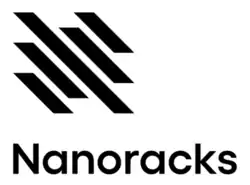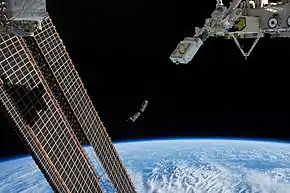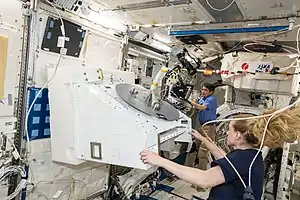Nanoracks
Nanoracks LLC is a private in-space services company.[1] Nanoracks is building tools to allow for the re-purposing of in-space hardware ("space junk") and turn it into agile space stations, which the company call Outposts.
 | |
| Industry | Aerospace |
|---|---|
| Founded | 2009 |
| Founder | Jeffrey Manber |
| Headquarters | , |
Number of locations | 5 (4 are terrestrial, 1 is lab space on ISS in low-Earth orbit) |
Key people | Jeffrey Manber and Charles Miller |
| Services | In-space services; Small satellite launch services; CubeSat launch services; Microgravity payload integration |
Number of employees | approximately 75 |
| Website | nanoracks |
Nanoracks's main office is in Houston, Texas, alongside the NASA Johnson Space Center. The business development office is in Washington, D.C., and additional offices are located in Abu Dhabi, United Arab Emirates (UAE) and Turin, Italy.[6][7] Nanoracks provides tools, hardware and services that allow other companies, organizations and governments to conduct research and other projects in space.
Some of Nanoracks customers include Student Spaceflight Experiments Program (SSEP), the European Space Agency (ESA), the German Space Agency (DLR), NASA, Planet Labs, Space Florida, Virgin Galactic, Adidas, Aerospace Corporation, National Reconnaissance Office (NRO), UAE Space Agency, Mohammed bin Rashid Space Centre (MBRSC), and the Beijing Institute of Technology. Nanoracks management created XO Markets, the first space holding company, to address differing local and international growth areas in the industry.[2]
History

Nanoracks was founded in 2009 by Jeffrey Manber [3] and Charles Miller [4][5][6] to provide commercial hardware and services for the U.S. National Laboratory on board the International Space Station via a Space Act Agreement with NASA. Nanoracks signed their first contract with NASA in September 2009 and had their first laboratory on the Space Station in April 2010.[7]
MirCorp CEO Jeff Manber oversaw the first and only commercially funded mission of the Russian space station, which lasted over 70 days. Manber was, and still is, the only American to ever work officially for the Roscosmos. As of January 2020, over 800 payloads have been deployed by Nanoracks to the International Space Station.[8] As of June 2015, Nanoracks has deployed 64 satellites into low Earth orbit, and had 16 satellites on the ISS awaiting deployment, with an order backlog of 99.[9] In 2012, a quarter of Nanoracks' revenue of over US$3 million came from NASA".[10]
In August 2012, Nanoracks partnered with Space Florida to host the Space Florida International Space Station (ISS) Research Competition.[11] As part of this program, Nanoracks and DreamUp provide research NanoLab box units to fly payloads to the ISS, with scientific research to be conducted on board the U.S. National Laboratory.[12] In October 2013, Nanoracks became the first company to coordinate the deployment of small satellites from the ISS via the airlock in the Japanese Kibō module. This deployment was done by Nanoracks using the Japanese Experiment Module (JEM) Small Satellite Orbital Deployer (J-SSOD).[13]
The Nanoracks CubeSat Deployer was launched on 9 January 2014, on the Orbital Sciences Cygnus Orb-1 Mission.[14] It became the first commercial platform to deploy satellites from the ISS.
In December 2014, DreamUp.org, the website for the educational arm of Nanoracks, was launched.[15] DreamUp offers access to commercial research platforms in suborbital and low Earth orbit. The DreamUp Advisory Board, made up of industry experts Ken Shields and Jeffrey Manber assigns "DreamUp Approved" status to projects declared realistic, doable, and in accordance with standard safety criteria. Through partnerships with organizations such as Student Spaceflight Experiments Program (SSEP) and Valley Christian High School, Nanoracks and DreamUp have helped launch dozens of student experiments to space and immerse hundreds of students in the space research experience.
In August 2015, Nanoracks announced a historic agreement to fly a Chinese DNA experiment from the Beijing Institute of Technology on the International Space Station. The agreement includes Nanoracks delivering the experiment to the American side of the ISS in a SpaceX Dragon spacecraft and berthing the experiment to Nanoracks' orbiting laboratory facilities. Nanoracks will then send data back to the Chinese researchers.[16]
In August 2015, the Nanoracks External Payload Platform (NREP) was successfully launched to the ISS on the fifth flight of the Japanese H-II Transfer Vehicle (HTV). The external platform will be able to accommodate up to nine 4U CubeSat-size payloads outside of the space station with a standard mission duration of 15 weeks. The platform is operational as of August 2016.[17][18]
In August 2015, Space Angels Network joined with Nanoracks and DreamUp to support and invest in STEM education and early stage-space companies by using the DreamUp Approved system.[19]
In December 2015, Nanoracks announced the formal creation of DreamUp, PBC. The goal behind DreamUp, PBC. was to make space research available to university students and researchers in the U.S. as well as a dozen other countries. In May 2016, Nanoracks and NASA signed a Space Act Agreement to develop a private airlock to be added to the International Space Station. In June 2017, Nanoracks and NASA sign a contract via the NextSTEP-2 award that focuses on repurposing spent launch vehicle upper stages.[20]
In October 2017, Nanoracks successfully deployed the Kestrel Eye IIM (KE2M) microsatellite via the company's Kaber Microsatellite Deployer from the International Space Station.[21]
In December 2018, Nanoracks announces the company has signed its first customer contract for a small satellite rideshare on the Indian Space Research Organisation's (ISRO) Polar Satellite Launch Vehicle (PSLV).
In September 2019, Nanoracks announces the opening of its first office in the United Arab Emirates (UAE) in Abu Dhabi's Hub71.[23]
Facilities and labs
Nanoracks Bishop Airlock
The Nanoracks Bishop Airlock is a commercially-funded airlock module launched to the International Space Station on SpaceX CRS-21 on 6 December 2020.[24][25] The module is being built by Nanoracks, Thales Alenia Space, and Boeing.[26] It will be used to deploy CubeSats, small satellites, and other external payloads for NASA, Center for the Advancement of Science in Space (CASIS), and other commercial and governmental customers.[27]
Nanoracks Space Outpost Program
Nanoracks is currently developing tools to convert space junk into commercial space stations (Outposts), to meet growing in-space customer demand. Outposts based on the Earthly concepts of re-use and recycle. The Outpost fleet will be made from spent upper stages in-orbit and other structures after they have completed their primary mission in space. Nanoracks will convert them into orbiting hubs for use by users all over the world. Nanoracks' Outposts are intended to be research labs, factories, fuel depots, hotels, and support systems to service missions throughout the Solar System.
Internal ISS Services
Nanoracks facilities on the International Space Station (ISS) include:
- Nanoracks Frame-3 accommodates a total of three 4U payloads (with the dimensions 10 x 20 x 20 cm) and has advanced features such as an internal computer with its own crew interface facility for easier payload software development. The Frame-3 can also provide up to 50 watts of power to a payload through a USB or other forms of data connections.
- Nanoracks MixStix – Nanoracks Mixture Enclosure Tubes (Mixstix) hold up to twenty-four mixing sticks. This enclosure allows for microgravity reactions and materials to be captured for analysis on the ISS, or returned to Earth via either the Soyuz or SpaceX Dragon. The MixStix are activated, and analysis begins, after the mixing stick is cracked open by an ISS crewmember, similar to activating a glow stick.
- Nanoracks Microscope-3 – the third generation Nanoracks microscope system is a hand-held USB digital microscope with 20-240X magnification that creates 5MP pictures or video. Seven white LEDs provide lighting and the scope has a polarizing filter to reduce glare. Microscope-3 can also be mounted to its XY translation stage for extra stability. Two microplate holders can accommodate low profile microplates. The microplate holders are black or white for the specific research background required.[28]
- Nanoracks Plate Reader-2 – a Molecular Devices SpectraMax M5e modified for space flight and the microgravity environment. This spectrophotometer analyzes samples by shining light (200-1000 nm) either on or through the top or bottom of each sample in the well of a microplate. The Nanoracks Plate Reader-2 can accommodate cuvettes in special microplate holders as well as 6-, 12-, 24-, 48-, 96-, and 384-well microplates. It can operate in absorbance, fluorescence intensity, or fluorescence polarization modes.[29][30] Laboratory space on the ISS is provided to Nanoracks by NASA under a contractual lease arrangement.[31]
- Nanoracks-Black Box is an essential part of Nanoracks's next-gen International Space Station platforms. This platform was designed to increase the payload turnover of autonomous payloads while simultaneously providing advanced scientific capabilities to customers, including the use of robotics, new automated MixStix, and NanoLab-style research. The platform itself is the size of a locker and can accommodate payloads up to 18U. Black Box was first utilized on the Cygnus CRS OA-5 resupply mission.
External ISS Services
Nanoracks deploys small CubeSats into orbit from the ISS through the Nanoracks CubeSat Deployer via the airlock in the Japanese Kibō module, after the satellites are transported to the ISS on a cargo spacecraft. When released, the small satellites are provided a push of about 1 m/s (3.3 ft/s) that begins a slow process of satellite separation from the ISS.[31]
The Nanoracks CubeSat Deployer (NRCSD) is a self-contained deployment system that mechanically and electrically isolates CubeSats from the ISS, the ISS crew, and cargo resupply vehicles. The design of the NRCSD is compliant with the ISS flight safety requirements and is space qualified. The deployer is composed of anodized aluminum plates, access panels, deployer doors, and a base plate assembly. The inside of the NRCSD is designed to minimize and/or preclude the jamming of CubeSat appendages during deployment.
External Platform (NREP)

The Nanoracks External Platform (NREP) was successfully installed in August 2016. The self-funded NREP is the first-ever commercial gateway-and-return to the extreme environment of space. Following the CubeSat form factor, payloads can now experience the microgravity, radiation and other harsh elements native to the space environment, observe earth, test sensors, materials, and electronics, all while having the opportunity to return the payload back to Earth.
The Nanoracks Kaber Microsat Deployer is a reusable system that allows the International Space Station to control and command satellite deployments. The Kaber was developed based on Nanoracks's experience deploying CubeSats from the ISS. This service enables Nanoracks to deploy microsatellites up to 82 kg into space. Microsatellites that are compatible with the Kaber Deployer have additional power, volume, and communication resources, which allows for deployments of higher scope and sophistication.
External Cygnus Deployer (E-NRCSD)
The satellite deployment service enabled satellites to be deployed at an altitude higher than the ISS via a Commercial Resupply Vehicle. These satellites are deployed after the completion of the primary cargo delivery mission and, soaring 500 kilometers above the Earth and ca. 100 kilometers above the ISS, this service opens the door for the development of new technology, in addition to extending the life of CubeSats already deployed in low-Earth orbit. The Cygnus Deployer holds a total volume of 36U and adds approximately two years to the lifespan of these satellites.
E-NRCSD missions:
- The Cygnus CRS OA-6 mission was launched 23 March 2016 at 03:05:52 UTC. Inside the Cygnus was the Saffire scientific payload. Mounted outside of the Cygnus was a CubeSat deployer by Nanoracks. Both of these systems remained inactive during the Cygnus docking at the ISS. After the CRS OA-6 resupply mission was completed, and the Cygnus was unberthed from the station, these two services got the chance to perform unprecedented, weeklong scientific experiments. The Saffire's purpose was to study combustion in microgravity, which was done once Cygnus left the ISS. Likewise, in between the CRS OA-6's initiation and its reentry into Earth's atmosphere, numerous Cubesats were deployed into orbit for the commercial entities that built and operate them.
- The Cygnus CRS OA-5 mission was launched 17 October 2016 at 23:45 UTC. On 25 November 2016, during the CRS OA-5 resupply mission, Nanoracks successfully deployed four Spire LEMUR-2 CubeSats from the Cygnus Cargo Vehicle from a 500-kilometer orbit. "The External Cygnus Deployment program was developed with the customer in-mind", says Nanoracks CTO Mike Lewis. Reusing and repurposing in-space vehicles is a quintessential part of Nanoracks's vision.
- The Cygnus CRS OA-7 mission was launched 18 April 2017 at 15:11:26 UTC. On Cygnus' eighth resupply mission, Nanoracks successfully deployed four Spire LEMUR-2 CubeSats at a nearly 500-kilometer orbit. Since then, Nanoracks has continued to grow its External Deployment program, which is focused on extending the mission of cargo vehicles after Cygnus's deployment from the ISS. This program is a stepping-stone in Nanoracks' larger goal: the repurposing of in-space vehicles. The CRS OA-7 launch accompanied the Company's largest CubeSat mission to date. During this mission, a total of 38 satellites were released into orbit.
- The Cygnus CRS OA-8E mission was targeting a launch in November 2017, with the Cygnus CRS OA-9E mission slated for May 2018.
PSLV services
Recently, Nanoracks announced that the company is adding polar orbit launches to their resume. The company plans to work with Berlin-based Astrofein to create and supply the deployers. In addition, Nanoracks is seeking help from the commercial arm of the Indian Space Research Organisation (ISRO), Antrix, for Polar Satellite Launch Vehicle (PSLV) services.
Due to recent customer demands for polar orbits, Nanoracks plans on seeing it through. These polar orbit opportunities come in addition to Nanoracks' numerous deployments of satellites via the Nanoracks CubeSat Deployer (NRCSD) and Kaber Deployer on the ISS as well as the External Nanoracks CubeSat Deployer (E-NRCSD) mounted outside of the Cygnus spacecraft.
Mars Demo-1
Mars Demo-1 (OMD-1) is a Nanoracks' first technology demonstration mission for the Outpost program,[32] flying mid-2021 on a SpaceX Rideshare mission. OMD-1 is a self-contained hosted payload platform that will demonstrate the robotic cutting of second stage representative tank material on-orbit. Nanoracks must prove being able to cut metal without producing any orbital debris.
Commercial Space Stations
Nanoracks, after finalizing its contract with NASA, and after winning NextSTEPs Phase II award, is now developing its concept Independence-1 (previously known as Ixion), which would turn spent rocket tanks into a habitable living area to be tested in space. In Spring 2018, Nanoracks announced that Ixion is now known as the Independence-1, the first 'outpost' in Nanoracks' Space Outpost Program.
References
- http://images.spaceref.com/docs/2014/here_to_mars_Manber_Testimony_040914.pdf
- http://nanoracks.com/wp-content/uploads/NanoRacks-Release-17-Emerge-and-Others-Join-NanoRacks.pdf
- "Our History". Nanoracks. Retrieved 18 February 2013.
- "The Space Show". Retrieved 25 January 2016.
- "DataFox". Retrieved 20 April 2015.
- "Space Policy Online". Archived from the original on 8 September 2015. Retrieved 14 September 2015.
- "Nanoracks Is Making Space Science Affordable For Everyone". Forbes. 21 November 2011. Retrieved 25 February 2013.
- http://www.nanoracks.com
- Foust, Jeff (12 June 2015). "Smallsat Developers Enjoy Growth In Launch Options". SpaceNews. Retrieved 13 June 2015.
- Knapp, Alex (4 March 2013). "The Space Station Is The Final Frontier Of Bio Research". Forbes. Retrieved 18 February 2013.
- https://www.spaceflorida.gov/
 This article incorporates text from this source, which is in the public domain.
This article incorporates text from this source, which is in the public domain. - http://www.dreamup.org/all-star-programs/#Space Florida ISS Research Competition
- "F-1 and companion CubeSats to be deployed to space from Kibō module on 27 September 2014: Kibō Utilization Office for Asia (KUOA) – International Space Station". iss.jaxa.jp. JAXA. Retrieved 7 December 2014.
- "Spaceflight, Nanoracks Team Up on CubeSat Launches". Parabolic Arc. Retrieved 7 December 2014.
- "DreamUp: Nanoracks Breaking New Ground in STEM Education". Nanoracks. Retrieved 19 December 2014.
- Berger, Eric (3 August 2015). "For the first time Chinese research to fly on NASA's space station". Houston Chronicle. Retrieved 3 August 2015.
- "Nanoracks External Platform, CubeSats, Launched to ISS on Japanese HTV-5". nanoracks.com. Nanoracks. Archived from the original on 29 December 2015.
- "Nanoracks External Platform Deployed Outside the ISS". nanoracks.com. Retrieved 22 September 2016.
- "Nanoracks and Space Angels Network Join Forces to Better Identify Promising Start Ups". Space Angels Network. Archived from the original on 27 October 2015. Retrieved 20 August 2015.
- "Nanoracks and NASA Sign NextSTEP Contract for Commercial Habitat Concept Study". nanoracks.com. Retrieved 12 June 2017.
- "Nanoracks Successfully Deploys First Customer Microsatellite from ISS". nanoracks.com. Retrieved 24 October 2017.
- "Nanoracks to Make Space More Accessible to the World from the United Arab Emirates / Hub71". nanoracks.com. Retrieved 18 September 2019.
- "Thales Alenia Space reaches key milestone for Nanoracks' airlock module" (Press release). Thales Alenia Space. 20 March 2019. Retrieved 22 August 2019.
- Clark, Stephen (2 August 2019). "SpaceX to begin flights under new cargo resupply contract next year". Spaceflight Now. Retrieved 22 August 2019.
- "Nanoracks, Boeing to Build First Commercial ISS Airlock Module". Nanoracks. 6 February 2017. Retrieved 22 August 2019.
- Garcia, Mark (6 February 2017). "Progress Underway for First Commercial Airlock on Space Station". NASA. Retrieved 22 August 2019.
 This article incorporates text from this source, which is in the public domain.
This article incorporates text from this source, which is in the public domain. - http://nanoracks.com/products/microscope/
- http://nanoracks.com/nanoracks-to-launch-second-generation-plate-reader-to-nasas-iss/
- https://www.moleculardevices.com/systems/microplate-readers/multi-mode-readers/spectramax-m-series-multi-mode-microplate-readers
- Foust, Jeff (24 March 2014). "Making the most of the ISS". The Space Review. 2014. Retrieved 27 March 2014.
- "Nanoracks Announces In-Space Outpost Demonstration". nanoracks.com. Nanoracks. 22 October 2019.